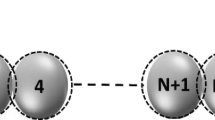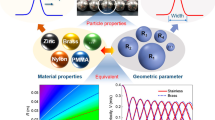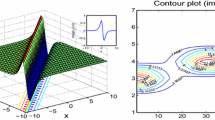Abstract
In the present exploration, some new wave profiles are constructed via Lie symmetry of transformations scheme by the one-dimensional optimal system in a pre-compressed one-dimensional granular crystal. Lie group scheme is used to construct the infinitesimal generators, entire vector field, commutation relations, and adjoint representations. Infinitesimal generators are used to construct one optimal system of the one-dimensional sub-algebras. Employing the optimal system, similarity reductions are obtained for the considered nonlinear model. Translational vectors and their linear combination are used to covert the assumed model in a nonlinear ordinary differential equation. These methods give us some new and interesting solutions which contain the trigonometric, hyperbolic trigonometric, and exponential type functions. To represent the physical significance of the assumed model, some 3D and 2D diagrams of acquired results are plotted by using Mathematica under the suitable choice of involving parameters values. The multiplier scheme is employed to describe the conserved vectors of the assumed problem.









Similar content being viewed by others
Data availability
My article has no related data.
References
X.J. Yang, M.J.A. Tenreiro, H.M. Srivastava, A new numerical technique for solving the local fractional diffusion equation: two-dimensional extended differential transform approach. Appl. Math. Comput. 274, 143–151 (2016)
M.A. Abdou, A.A. Soliman, New exact travelling wave solutions for space-time fractional nonlinear equations describing nonlinear transmission lines. Results Phys. 9, 1497–1501 (2018)
N.F.M. Noor, R.U. Haq, S. Abbasbandy, I. Hashim, Heat flux performance in a porous medium embedded Maxwell fluid flow over a vertically stretched plate due to heat absorption. J. Nonlinear Sci. Appl. 9, 2986–3001 (2016)
M. Abdelrahman, E.H.M. Zahran, M.M.A. Khater, The exp\((- \phi (\xi ))\)-expansion method and its application for solving nonlinear evolution equations. Int. J. Mod. Nonlinear Theory Appl. 4, 37–47 (2015)
M.A. Akbar, N.H.M. Ali, R. Roy, Closed form solutions of two time fractional nonlinear wave equations. Results Phys. 9, 1031–1039 (2018)
J.G. Liu, M.S. Osman, W.H. Zhu, L. Zhou, G.P. Ai, Different complex wave structures described by the Hirota equation with variable coefficients in inhomogeneous optical fibers. Appl. Phys. B 125, 175 (2019)
M.T. Islam, M.A. Akbar, A.K. Azad, Traveling wave solutions to some nonlinear fractional partial differential equations through the rational \((G^{\prime }/G)\)expansion method. J. Ocean Eng. Sci. 3, 76–81 (2018)
M.A. Mohammed, A.I.N. Ibrahim, Z. Siri, N.F.M. Noor, Mean Monte-Carlo finite difference method for random sampling of a nonlinear epidemic system. Sociol. Methods Res. 48(1), 34–61 (2016)
O.A. Ilhan, J. Manafian, M. Shahriari, Lump wave solutions and the interaction phenomenon for a variable-coefficient Kadomtsev-Petviashvili equation. Comput. Math. Appl. 78, 2429–2448 (2019)
J. Manafian, O.A. Ilhan, A. Alizadeh, Periodic wave solutions and stability analysis for the KP-BBM equation with abundant novel interaction solutions. Phys. Scr. 95, 065203 (2020)
H.M. Baskonus, H. Bulut, T.A. Sulaiman, New complex hyperbolic structures to the Lonngren wave equation by using sine-Gordon expansion method. Appl. Math. Nonlinear Sci. 4, 129–138 (2019)
M.F. El-Sayed, G.M. Moatimid, M.H.M. Moussa, R.M. El-Shiekh, M.A. Khawlani, New exact solutions for coupled equal width wave equation and (2+1)-dimensional Nizhnik-Novikov-Veselov system using modified Kudryashov method. Int. J. Adv. Appl. Math. Mech. 2, 19–25 (2014)
K. Khan, M. A. Akbar, N. H. M. Ali, The modified simple equation method for exact and solitary wave solutions of nonlinear evolution equation: the GZK-BBM equation and right-handed non-commutative Burgers equations, Int. Sch. Res. Not. 146704 (2013)
R. Islam, K. Khan, M.A. Akbar, M.E. Islam, M.T. Ahmed, Traveling wave solutions of some nonlinear evolution equations. Alex. Eng. J. 54, 263–269 (2015)
M.A. Akbar, N.H.M. Ali, The improved F-expansion method with Riccati equation and its applications in mathematical physics. Cogent Math. 4, 1282577 (2017)
S. Zhang, J. Li, L. Zhang, A direct algorithm of exp-function method for non-linear evolution equations in fluids. Therm. Sci. 20, 881–884 (2016)
M.A. Akbar, N.H.M. Ali, J. Hussain, Optical soliton solutions to the (2+1)- dimensional Chaffee-Infante equation and the dimensionless form of the Zakharov equation. Adv. Differ. Equ. 2019(1), 1–18 (2019)
A. F. Qasim, E. S. Al-Rawi, Adomian decomposition method with modified Bernstein polynomials for solving ordinary and partial differential equations, J. Appl. Math. 1803107 (2018)
M.S. Osman, H. Rezazadeh, M. Eslami, Traveling wave solutions for (3+1) dimensional conformable fractional Zakharov-Kuznetsov equation with power law non-linearity. Nonlinear Eng. 8, 559–567 (2019)
M.S. Osman, New analytical study of water waves described by coupled fractional variant Boussinesq equation in fluid dynamics. Pramana J. Phys. 93, 26 (2019)
H. Rezazadeh, M.S. Osman, M. Eslami, M. Mirzazadeh, Q. Zhou, S.A. Badri, A. Korkmaz, Hyperbolic rational solutions to a variety of conformable fractional Boussinesqlike equations. Nonlinear Eng. 8, 224–230 (2019)
B. Ghanbari, M.S. Osman, D. Baleanu, Generalized exponential rational function method for extended Zakharov Kuznetsov equation with conformable derivative. Mod. Phys. Lett. A 34, 1950155 (2019)
A. M. Shahoot, K. A. E. Alurrfi, I. M. Hassan, A. M. Almsri, Solitons and other exact solutions for two nonlinear PDEs in mathematical physics using the generalized projective Riccati equations method, Adv. Math. Phys. 6870310 (2018)
M.S. Osman, One-soliton shaping and inelastic collision between double solitons in the fifth-order variable-coefficient Sawada-Kotera equation. Nonlinear Dyn. 96, 1491–1496 (2019)
A. Javid, N. Raza, M.S. Osman, Multi-solitons of thermophoretic motion equation depicting the wrinkle propagation in substrate-supported graphene sheets. Commun. Theor. Phys. 71, 362–366 (2019)
W.P. Hu, Z.C. Deng, S.M. Han, W. Fa, Multi-symplectic Runge-Kutta methods for Landau Ginzburg-Higgs equation. Appl. Math. Mech. 30, 1027–1034 (2009)
K.R. Raslan, K.K. Ali, M.A. Shallal, The modified extended tanh method with the Riccati equation for solving the space-time fractional EW and MEW equations. Chaos Solitons Fractals 103, 404–409 (2017)
D. Lu, M.S. Osman, M.M.A. Khater, R.A.M. Attia, D. Baleanu, Analytical and numerical simulations for the kinetics of phase separation in iron (Fe-Cr-X (X=Mo, Cu)) based on ternary alloys. Physica A 537, 122634 (2020)
S. Malik, H. Almusawa, S. Kumar, A.-M. Wazwaz, M.S. Osman, A (2+1)-dimensional Kadomtsev-Petviashvili equation with competing dispersion effect: Painlevé analysis, dynamical behavior and invariant solutions. Results Phys. 23, 104043 (2021)
H. Almusawa, R. Ghanam, G. Thompson, Lie Symmetries of the Canonical Connection: Codimension One Abelian Nilradical Case. J. Non. Math. Phy. 28, 242–253 (2021)
S. Kumar, H. Almusawa, A. Kumar, Some more closed-form invariant solutions and dynamical behavior of multiple solitons for the (2+1)-dimensional rdDym equation using the Lie symmetry approach. Results Phys. 24, 104201 (2021)
A. Akbulut, H. Almusawa, M. Kaplan, M.S. Osman, On the Conservation Laws and Exact Solutions to the (3+1)-Dimensional Modified KdV-Zakharov-Kuznetsov Equation. Symmetry 13, 765 (2021)
M.B. Riaz, A. Jhangeer, K.M. Abualnaja, M. Junaid-U-Rehman, Conserved quantities and travelling wave profiles to the nonlinear transmission line via Lie group analysis. Physica Scripta 96(10), 104013 (2021)
S.C. Anco, G.W. Bluman, Direct construction method for conservation laws of partial differential equations. Part I: examples of conservation law classifications. European J. Appl. Math. 13(5), 545–566 (2002)
M. Liu, H. Dong, On the existence of solution. Lie symmetry analysis and conservation law of magnetohydrodynamic equations. Commun. Nonlinear Sci. Numer. Simul. 87, 105277 (2020)
V.F. Nesterenko, Propagation of nonlinear compression pulses in granular media. J. Appl. Mech. Phys. 24, 733 (1983)
Z.-G. Liu, J. Zhang, Y.-S. Wang, G. Huang, Analytical solutions of solitary waves and their collision stability in a pre-compressed one-dimensional granular crystal. Nonlinear Dyn. 104, 4293–4309 (2021)
K.K. Ali, R. Yilmazer, A. Yokus, H. Bulut, Analytical solutions for the (3+1)-dimensional nonlinear extended quantum Zakharov-Kuznetsov equation in plasma physics. Physica A 548, 124327 (2020)
S. Kumar, D. Baleanu, Numerical solution of two-dimensional time fractional cable equation with Mittag-Leffler kernel. Math. Meth. Appl. Sci. 43, 8348–8362 (2020)
S. Kumar, A. Atangana, A numerical study of the nonlinear fractional mathematical model of tumor cells in presence of chemotherapeutic treatment. Int. J. Biomath. 13, 2050021 (2020)
S. Kumar, D. Baleanu, A New Numerical Method for Time Fractional Non-linear Sharma-Tasso-Oliver Equation and Klein-Gordon Equation With Exponential Kernel Law. Front. Phys. 810, 00136 (2020)
S. Kumar, P. Pandey, Quasi wavelet numerical approach of nonlinear reaction diffusion and integro reaction-diffusion equation with Atangana-Baleanu time fractional derivative. Chaos, Solitons and Fractals 130, 109456 (2020)
A. Jhangeer, A. Hussain, M. Junaid-U-Rehman, D. Baleanu, M.B. Riaz, Quasi-periodic, chaotic and travelling wave structures of modified Gardner equation. Chaos, Solitons and Fractals 143, 110578 (2021)
A.R. Seadawy, M. Iqbal, D. Baleanu, Construction of traveling and solitary wave solutions for wave propagation in nonlinear low-pass electrical transmission lines. J. King Saud Univ.-Sci. 32, 2752–2761 (2020)
M.M.A. Khater, D. Baleanu, On abundant new solutions of two fractional complex models. Adv. Differ. Equ. 2020(1), 1–14 (2020)
S.A. Iqbal, M.G. Hafez, S.A. Abdul-Karim, Bifurcation analysis with chaotic motion of oblique plane wave fordescribing a discrete nonlinear electrical transmission line with conformable derivative. Results Phys. 18, 1033092 (2020)
M.G. Hafez, Nonlinear ion acoustic solitary waves with dynamical behaviours in the relativistic plasmas. Astrophys. Space Sci. 365(5), 1–11 (2020)
S. Sahoo, S.S. Ray, Lie symmetry analysis and exact solutions of (3+1) dimensional Yu-Toda-Sasa-Fukuyama equation in mathematical physics. Comput. Math. Appl. 73, 253–260 (2017)
A. Chauhan, R. Arora, Time fractional Kupershmidt equation: symmetry analysis and explicit series solution with convergence analysis. Commun. Math. 27(2), 171–185 (2019)
H. Gandhi, A. Tomar, D. Singh, Conservation laws and exact series solution of fractional order Hirota-Satsoma coupled Korteveg-de-Vries system by symmetry analysis. Math. Methods Appl. Sci. 44(18), 14356–14370 (2021)
M.A. Khan, M.A. Akbar, N.N. BintiAbd Hamid, Traveling wave solutions for space-time fractional Cahn Hilliard equation and space-time fractional symmetric regularized long-wave equation. Alex. Eng. J. 60(1), 1317–1324 (2021)
A. Jhangeer, A. Hussain, M. Junaid-U-Rehman, I. Khan, D. Baleanu, K.S. Nisar, Lie analysis, conservation laws and travelling wave structures of nonlinear Bogoyavlenskii-Kadomtsev-Petviashvili equation. Results Phys. 19, 103492 (2020)
M.B. Riaz, A. Atangana, A. Jhangeer, M. Junaid-U-Rehman, Some exact explicit solutions and conservation laws of Chaffee-Infante equation by Lie symmetry analysis. Phys. Scr. 96, 084008 (2021)
D. Kumar, S. Kumar, Some new periodic solitary wave solutions of (3+1)-dimensional generalized shallow water wave equation by Lie symmetry approach. Comput. Math. Appl. 78, 857–877 (2019)
L. V. Ovsiannikov, Group analysis of differential equations academic, New York (1982)
X. Hu, Y. Li, Y. Chen, A direct algorithm of one-dimensional optimal system for the group invariant solutions. J. Math. Phys. 56, 053504 (2015)
N. Raza, A. Jhangeer, R. Ur Rahman, A.R. Butt, Yu-Ming. Chu, Sensitive visualization of the fractional wazwaz-benjamin-bona-mahony equation with fractional derivatives: A comparative analysis. Results Phys. 25, 104171 (2021)
Acknowledgements
This Research was supported by Taif University Researchers Supporting Project Number (TURSP-2020/217), Taif University, Taif, Saudi Arabia and encouraged by the Polish National Science Centre under the grant OPUS 18 No. 2019/35/B/ST8/00980.
Author information
Authors and Affiliations
Ethics declarations
Conflict of interest
The authors proclaim that they have no acknowledged contesting fiscal concerns or personal relationships that could have seemed to persuade the work reported in this article.
Appendix
Appendix
1.1 Multiplier approach
Here, we will describe the general method in detail (see [53]):
Suppose, we have a general nonlinear partial differential equation of integer order:
where \(\Phi =\Phi (\theta ,\tau )\) and \(\theta \) and \(\tau \) are space and temporal components. Some steps of the technique are given below.
(1) The total differential operator may be defined as:
where \({\Phi }_{i}\) indicates the derivative w.r.t \(\theta ^{i}\) and \({\Phi }_{ij}\) displays the derivative w.r.t \(\theta ^{i}\) and \(\theta ^{j}\).
(2) The Euler operator is defined as:
\(\mathbf {(3)}\) An n-tuple \({\mathfrak {f}}=({\mathfrak {f}}^{1},{\mathfrak {f}}^{2},{\mathfrak {f}}^{3},...,{\mathfrak {f}}^{m})\), \(i=1,2,...m\), we get
which satisfies the entire solutions of Eq. (77), and Eq. (74) is named as the local conserved vectors.
(4) The property of \(\Lambda (\theta , \tau , {\Phi })\) of Eq. (77):
for some function \({\Phi }(\mu ^{1},\mu ^{2},...,\mu ^{m})\).
(5) We obtain the determining equations for multiplier \(\Lambda (\theta , \tau , {\Phi })\) when we take the derivative of Eq. (75):
Equation (76) contains for few function \({\Phi }(\mu ^{1}, \mu ^{2}, . . . , \mu ^{m})\) not just for solutions of Eq. (77).
When the multiplier \(\Lambda (\theta , \tau , {\Phi })\) are achieved by use of Eq. (76), the conserved vectors may be obtained by Eq. (75) just as the determining equation.
1.2 New auxiliary method
Suppose, we have a general nonlinear partial differential equation in the following expression:
where \(\Phi =\Phi (\theta ,\tau )\), \(\theta \) and \(\tau \) are space and temporal components, respectively. Some steps of the technique are given below.
Step: 1 Assuming the new dependent and independent variables
Here, \(\rho \) is new independent variable, where \(k_1\) and c are real parameter for Eq. (77). Using Eq. (78) into Eq. (77), we obtain the following ordinary differential equation of the form:
Step: 2 Assume the solution for Eq. (79) of the type
where \(b_i\)’s are constants which are to be found later, and also first-order ODE satisfy \(f(\rho )\).
Step: 3 To find the value of k in Eq. (80), we use the balancing procedures, i.e., the highest-order derivative is balanced by the highest degree nonlinear term.
Step: 4 Substituting Eq. (80) and Eq. (81) into Eq. (77) and collecting the coefficients of the powers of \({\mathfrak {F}}^{f(\rho )} (i=0,1,2,3..)\). After collecting the like term, we put them equal to zero and we have a collection of equations and then solving these by computer algebra system (CAS), i.e., Mathematica.
Step: 5 The category of solutions for Eq. (81) may be obtained as:
Family:1 When \({\kappa _{1}}^2-{\kappa _{2}}{\kappa _{3}}<0\) and \({\kappa _{3}}\ne 0\)
Family:2 When \({\kappa _{1}}^2-{\kappa _{2}}{\kappa _{3}}>0\) and \({\kappa _{3}}\ne 0\)
Family:3 When \({\kappa _{1}}^2+{\kappa _{2}}^2>0\) and \({\kappa _{3}}\ne 0\) and \({\kappa _{3}}\ne -{\kappa _{2}}\)
Family: 4 When \({\kappa _{1}}^2+{\kappa _{2}}^2<0\), \({\kappa _{3}}\ne 0\) and \({\kappa _{3}}\ne -{\kappa _{2}}\)
Family: 5 When \({\kappa _{1}}^2-{\kappa _{2}}^2<0\) and \({\kappa _{3}}\ne -{\kappa _{2}}\)
Family: 6 When \({\kappa _{1}}^2-{\kappa _{2}}^2>0\) and \({\kappa _{3}}\ne -{\kappa _{2}}\)
Family: 7 When \({\kappa _{2}}{\kappa _{3}}<0\), \({\kappa _{3}}\ne 0\) and \({\kappa _{1}}=0\)
Family: 8 When \({\kappa _{1}}=0\) and \({\kappa _{2}}=-{\kappa _{3}}\)
Family: 9 When \({\kappa _{1}}^2={\kappa _{2}}{\kappa _{3}}\)
Family: 10 When \({\kappa _{1}}=k\), \({\kappa _{2}}=2k\) and \({\kappa _{3}}=0\)
Family: 11 When \({\kappa _{1}}=k\), \({\kappa _{3}}=2k\) and \({\kappa _{2}}=0\)
Family: 12 When \(2{\kappa _{1}}={\kappa _{2}}+{\kappa _{3}}\)
Family: 13 When \(-2{\kappa _{1}}={\kappa _{2}}+{\kappa _{3}}\)
Family: 14 When \({\kappa _{2}}=0\)
Family: 15 When \({\kappa _{2}}={\kappa _{1}}={\kappa _{3}}\ne 0\)
Family: 16 When \({\kappa _{2}}={\kappa _{3}}\), \({\kappa _{1}}=0\)
Family: 17 When \({\kappa _{3}}=0\)
Step: 6 Using all the values of \(\mathfrak {F}^{f(\rho )}\) from step: 5 into Eq. (80), we get the results for Eq. (77).
Rights and permissions
About this article
Cite this article
Riaz, M.B., Awrejcewicz, J., Jhangeer, A. et al. Some new wave profiles and conservation laws in a Pre-compressed one-dimensional granular crystal by Lie group analysis. Eur. Phys. J. Plus 137, 401 (2022). https://doi.org/10.1140/epjp/s13360-022-02619-5
Received:
Accepted:
Published:
DOI: https://doi.org/10.1140/epjp/s13360-022-02619-5




